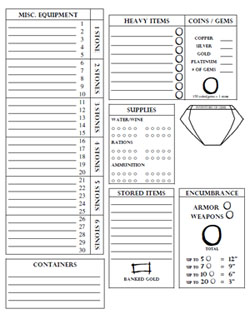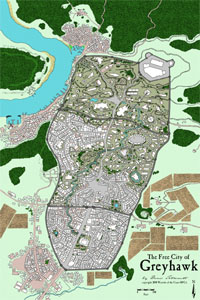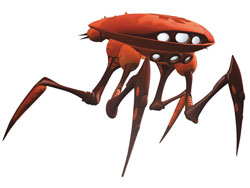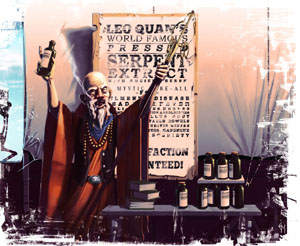This is an equipment sheet designed to be used with the Encumbrance by Stone rules I posted yesterday.
USING THE SHEET
Using the sheet is really where this system comes alive, because it basically makes tracking encumbrance as easy as listing what you’re carrying.
Armor/Shield/Weapons: The assumption is that your currently equipped armor, shield, and weapons will be listed for reference on the front of your character sheet. You can jot down the current encumbrance values for these items in the spaces provided in the lower right hand corner of the sheet.
Coins/Gems: These are listed in the upper right and their encumbrance calculated as shown. (To quench the “I have one coin and it apparently weighs a ton” complaints, you can allow players who carrying 20 coins or less to list them as “loose change” in the miscellaneous equipment section.)
Heavy Items: This section is for listing anything that qualifies as a heavy item (i.e., weighs 1 or more stones all by itself).
Miscellaneous Items: The heart of the sheet. Simply list everything you’re carrying in bundles of 20 or less. When you’re done, you can immediately see how many stones of miscellaneous equipment you’re carrying. Bam.
Add Misc. Equipment + Heavy Items + Coins/Gems + Armor + Shield + Weapons = Total Encumbrance. In practice this is all single digit arithmetic and adjusting your encumbrance on-the-fly during an adventure is practically automatic.
Moved equipment to your horse? Picked up a bunch of treasure? Throwing away your shield in order to run away from the goblin horde at your heels? It can all be done in seconds.
TIPS AND TRICKS
Stored Items: This section of the sheet is for anything you own that isn’t currently being carried by your character.
Inventory of Gems: These are tracked separately to make calculating coin/gem encumbrance easier.
Containers: This area is used for listing containers in use (which don’t count against encumbrance). Empty containers should be listed as miscellaneous equipment. There are two easy methods for tracking which items are in which container:
(1) List miscellaneous equipment slot numbers next to the container.
(2) Put a symbol (star, circle, square, etc.) next to the container, then mark items in the container with the same symbol.
Tracking Supplies: The intention is that you list your supplies in the miscellaneous equipment section, but you can quickly check off supplies used on the trackers. At some point of convenience, you can go through your equipment list, adjust the totals, and then erase the supply checklists to start anew.
The Blank Space: After making the sheet I kept expecting something to crop up that I’d forgotten. (At which point I’d have this convenient blank space to slot it into.) After a half dozen sessions, nobody has suggested anything. (Let me know if you think of something.)
















